We left Vienna after breakfast headed west toward Salzburg with an intermediate stop planned at Melk Abbey. I’ll note here that those of you who abhor puns should be delighted you weren’t on our small bus this morning because I knew from the start that I was going to Melk this for all it was worth and I understand that it was only the Melk of human kindness that prevented the group finding some way of stopping the udderly endless stream of puns I squeezed from my brain and out my mouth or perhaps even going so far as mooving me out of the vehicle. Here, I’ll thank them for their forbearance and, for you, reader, I’ll stop now. (Not really.)
Drinking it all in – a stop at Melk Abbey.
Had we made a non-stop trip from our hotel in Vienna to our hotel in Salzburg it would have taken about three hours to cover a bit less than 300 kilometers. Assuming a 09:00 or 09:30 departure time means we would have arrived at about noon or in that awkward hotel timeslot when rooms are rarely available for new guests to check-in. So, making an intermediate stop was eminently sensible. The choice of Melk Abbey was equally sensible given that it’s about one-third of the way. With a guided tour, some free time to wander the church and grounds, and perhaps have some lunch we would arrive in Salzburg both with our rooms available and some time to walk around if we wanted. By choice, I sat in the back of the van making this
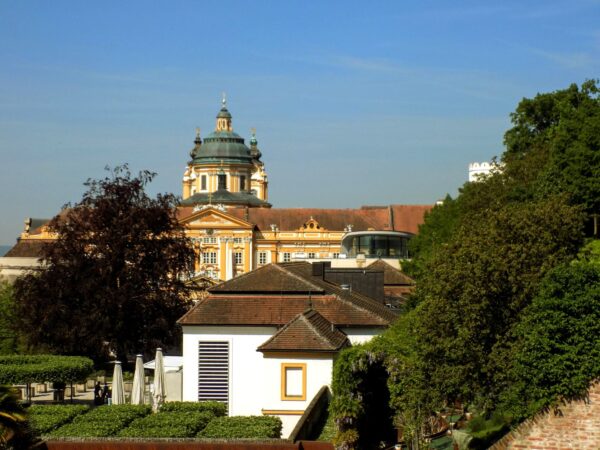
my first look at the Abbey.
The use of the land overlooking the Wachau Valley as a religious site long predates the establishment of the abbey that was founded in 1089 when Leopold II, Margrave of Austria, gave one of his castles to Benedictine monks from Lambach Abbey. The land was first sanctified near the end of the eighth century when Charlemagne transferred ownership of Melk, Kirchberg an der Pielach, and Grünz to Deocar – who was both the abbot of Herrieden Abbey and his court chaplain. A Franciscan monk who would later be canonized, Deocar, led his order in the only missionary work in the Holy Roman Empire’s newly acquired Östmark territory.
In 976, the Babenbergs built a castle in Melk and Leopold II Babenberg brought Benedictines there from Lambach in 1089. The monks established a monastic school on the site in the 12th century, the Stiftsgymnasium Melk, in the process building a monastic library with an extensive manuscript collection that brought the monastery great fame.
Two buildings predated the Baroque architectural masterpiece we see today. The first was destroyed by a fire in 1297 and its replacement, while not destroyed, was badly damaged during the Ottoman invasion in 1683. In the early 18th century, the abbot ordered the old building razed to make way for a new design by a famous Austrian baroque architect Jakob Prandtauer.
The preservation of the abbey grew precarious when, in the late eighteenth century, Habsburg Emperor Joseph II pursued an aggressive policy of secularization sometimes called Josephinism. He viewed monasteries as hotbeds of superstition and a breeding ground for religious fanaticism so he ordered them dissolved. All monasteries, regardless of their gender makeup, were deemed useless by the standards Joseph II established. The government took their revenues for use in pious establishments they judged useful to religion and humanity. In another act the government transformed the seized monasteries into hospitals, colleges, or military barracks. Despite these aggressive imperial actions, Melk Abbey survived as an abbey. The reputation of its school, its manuscript library, and its scriptorium that had become renowned for its production of manuscripts are the factors that likely saved the abbey from seizure and dissolution.
Certainly, visiting the abbey provides some beautiful views of the town of Melk,

and the surrounding Wachau Valley,

and the garden was an interesting and soothing space.
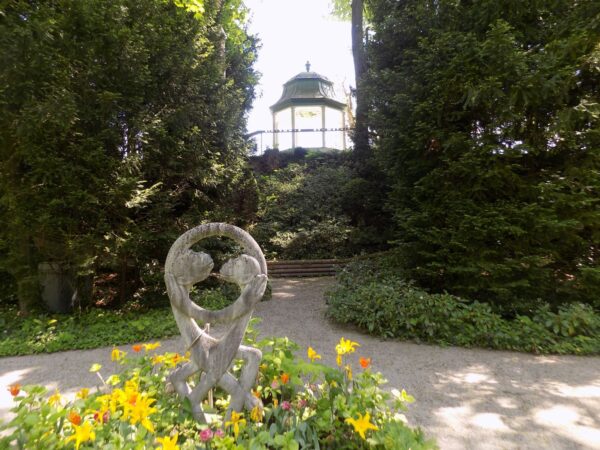
But beyond this, the visit, for me, was rather hollow. (Those of you familiar with my history know that I carry a bias of antipathy to most manifestations of religion – whether physical or “spiritual” and even more so to these institutional displays that are, in my view, intended to intimidate the masses by overwhelming them with shows of knowledge, wealth, and power. Certainly, some denominations engage in this more extensively than others but most practice this dynamic in some way. The entry ticket cost €13 and yet you can see gold nearly everywhere in the abbey. It rankles me.)
On to Salzburg.
We left the abbey after lunch and continued our transit to Salzburg reaching our hotel which was on the east side of the river, in the later part of the afternoon. After checking into our rooms, I met Bob and Betty on the rooftop restaurant that had a wonderful view of the old city, the castle and the Alps beyond
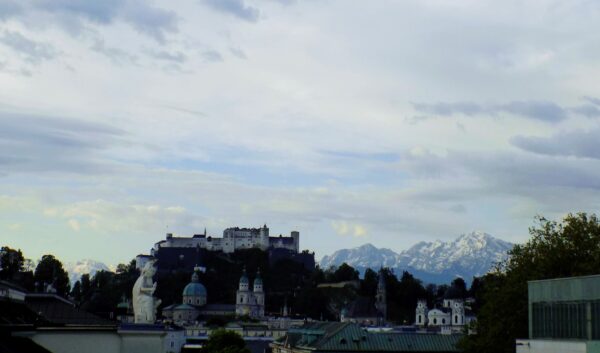
(I took this photo the next morning before breakfast.) We had a lovely chat about the trip to date and Bob was kind enough to treat me to my beer. They stayed behind for dinner while I set off to the Mirabell Garden.
Salzburg is, I think, famous for three things. Until the later part of the 18th century likely the only thing Salzburg would have been known for was the nearby Berchtesgaden salt mine that’s now in Germany. (It is the salt city, after all.) Sometime after 1756, of course, it gained a new notoriety as the birthplace of W A Mozart. Finally, in 1964 it was featured in the film The Sound of Music. While the film wasn’t shot entirely in Salzburg, the city appears throughout and one of the principal shooting locations was the Mirabell Garden. Fortunately for me, the garden was a mere 350 meters south of the hotel on Rainerstraße. Even Google Maps couldn’t confuse me this time.
Mirabell.
Since it was so close, I knew I’d be able to visit it again so I went without my list of Sound of Music spots that I should photograph. (And that list was quite specific. It included not only the specific element but a time stamp as well.) Although when I set out, I expected this would only be a bit of exercise (needed since we’d spent hours on our bus) and an orientation, when I reached the garden, I was enchanted. It was simply a delightful place – verdant, floral, and
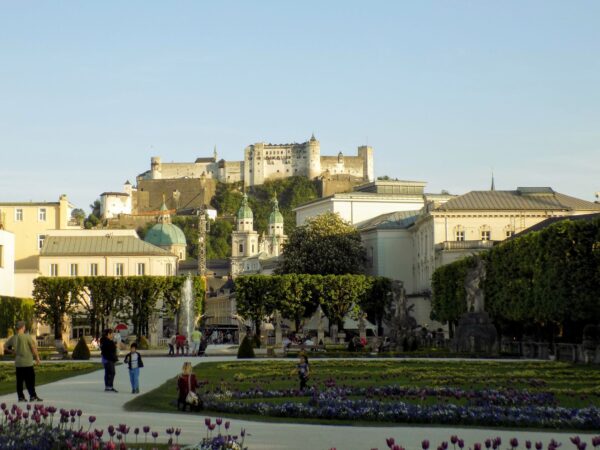
filled with whimsy.
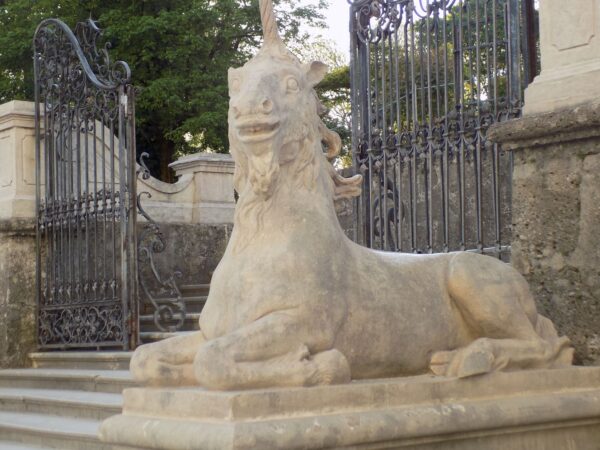
I made a special trip to the Zwergerlgarten (Dwarf Garden) section. The figures were installed in the late 17th century beginning in 1690 or 1691 and completed in 1695. They’re made of white (though now quite discolored with age) Untersberg marble. The garden originally contained 28 statues. Though I didn’t count, I think only 13 remain.
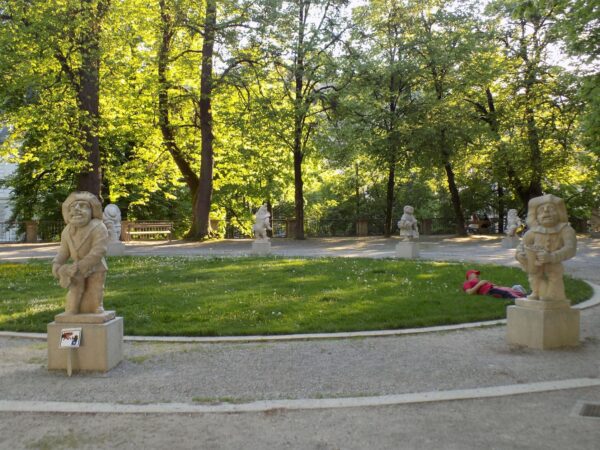
It was growing a bit late and I was getting a bit hungry so I started on a circuitous route back to the hotel when I happened upon the Heart of Joy – a vegetarian restaurant and I was able to sneak in about 20 minutes before they closed. I had the “Heart of Joy Salad” with fried tofu and something called Red Cashew Raw cake for dessert with a cup of English Breakfast tea because as I recall this was the only real tea on the menu all the others were some sort of tisane.
As I sat over my dinner, I thought about what was, for me, the main disappointment of the day. This was Shlomit’s announcement that since the only performance available had a program quite similar to the one we’d seen in Vienna on Sunday, if we wanted to attend any concert in Salzburg, we’d have to do so on our own.
Tomorrow we would have our more formal introduction to Salzburg with a guided walking tour in the morning followed by a special group lunch. We’d also be given tickets to both Mozart’s birth house and the Mozart apartment to explore them and other places in Salzburg at our leisure. My feeling that night was that while Salzburg was and would be charming, with no concert, I’d have preferred an extra day in Prague. Time would tell if that feeling persisted.
In the next post, I’ll take you on a bit of a Sound of Music detour before I look at how I spent the day. Meanwhile, here are the remaining photos from the day.